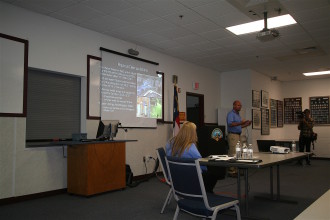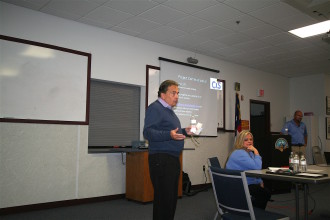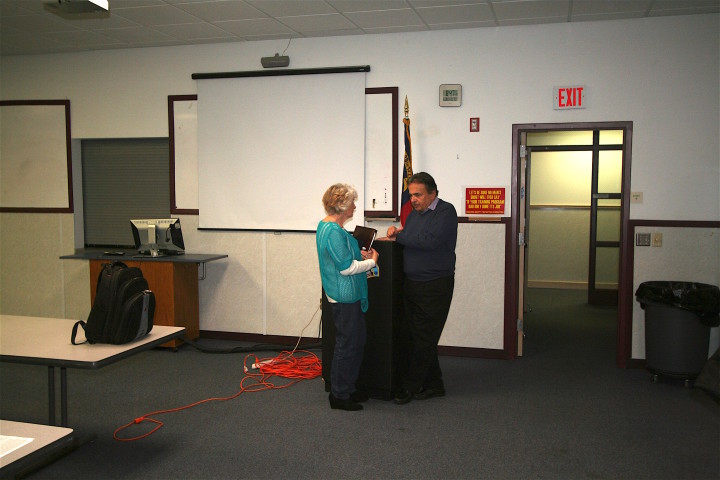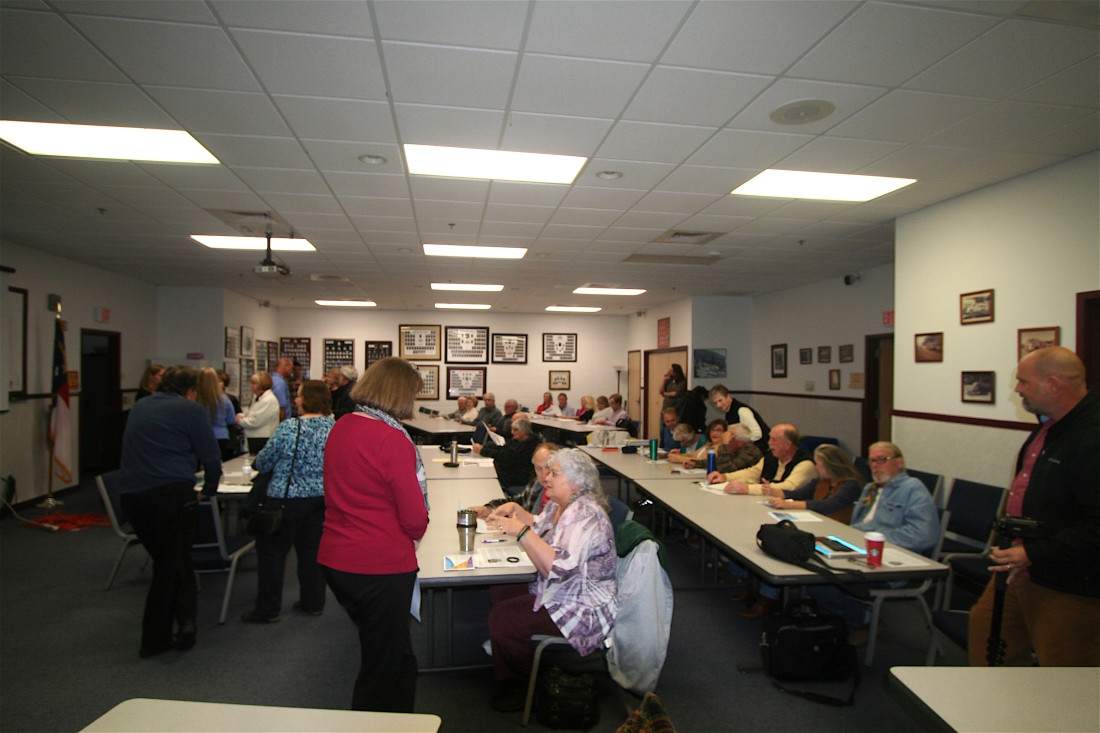ASHEVILLE, NC — Cleanup efforts are finally beginning at the CTS of Asheville Superfund site on Mills Gap Road, but past controversies and a lack of trust in Environmental Protection Agency officials continued to dominate the discussion during a Nov. 30 public meeting to review the impending remedial projects and address residents’ concerns.
The crowd at the Skyland Fire Department comprised an array of U.S. EPA staffers, county representatives, an official from the CTS Corporation, a documentary film crew, members of two community advisory groups and residents concerned about the potential impacts of the cleanup strategies.
While EPA officials tried to strike an optimistic tone about the potential remedial effects of the proposed electrical resistance heating and in-situ chemical oxidation systems that will be used on the site in coming years, many attendees continued to express ambivalence about a lack of action since contamination was discovered at the site decades ago.
Steam-cleaning
The meeting kicked off with a presentation from EPA’s Craig Zeller, who has served as CTS’ site manager since 2015. Zeller provided an abridged history of the roughly 9-acre property before delving into the particulars of the two-part interim cleanup plan, which EPA and its hired contractor, TRS Group, Inc., will begin constructing in December.
“A lot of work is going on at the site currently,” Zeller said. Work crews are preparing to install the ERH system over approximately one acre of the property that EPA has pinpointed as the source of trichloroethylene, or TCE, contamination. TCE was commonly used as a degreaser at electroplating facilities like the CTS of Asheville plant, which operated from 1952 to 1986.

The ERH system will consist of several hundred electrodes placed in holes drilled down to the source contamination. These electrodes will then heat the target area to 87 degrees Celsius, essentially vaporizing the contaminants, which will be vacuumed out of the ground and captured in a vapor-recovery well, then separated from groundwater and petroleum and disposed of offsite. (See “In situ remediation could revitalize hazardous waste sites,” Xpress, Feb. 23, 2017)
Zeller referred to the ERH strategy as the “silver bullet” of environmental remediation, estimating that it will reduce up to 95 percent of the TCE concentrations lodged within soil and groundwater over a period of 90-120 days.
TRS Group and the EPA will be working through the winter and spring to prepare the system to go online by May in order to meet Duke Energy’s prescribed window in which it could provide the 8.51 kilowatt hours of energy needed to power the ERH system.
“We’re very excited to begin work on the project,” Zeller said, noting that the success of the ERH system will determine what steps the EPA will take in the future to clean up the site. “ERH is the most aggressive [remedial] approach for this setting.”
Making contact
Zeller also outlined the in-situ chemical oxidation pilot study that will take place on an additional 1.9 acres of the CTS property. The agency will install three injection wells on-site between December 2017 and February 2018. The wells will insert a potassium permanganate slurry into the ground in an attempt to chemically dissolve the TCE. (See “In situ remediation could revitalize hazardous waste sites,” Xpress, Feb. 23, 2017)
“Chemical oxidation is a contact sport,” Zeller explained, noting that the EPA will be monitoring the process to determine its success rate over the next year. Officials will then review the data collected and design a full-scale strategy for the process, which he estimated will be installed in April 2019.
Several residents questioned Zeller regarding safety concerns associated with the ERH system, as well as its effects on plant life and surrounding soil. Zeller said an air monitoring system featuring four on-site stations will be installed. Additionally, security personnel and cameras will keep trespassers away.
The air monitors will alert TRS Group if air output from the ERH system reaches 59 micrograms per cubic meter, the North Carolina state limit for TCE concentrations in ambient outdoor air. In the case of system malfunction, Zeller added, the ERH system will shut down automatically, stopping any additional release of vapors.
“The monitors are highly accurate, down to the parts per billion,” Zeller assured those at the meeting. “There has been no demonstrated effect on plant life. No one will feel a temperature difference in the ground or their basement or anything like that.”

Throughout the process, EPA will continue to vigorously sample bedrock and surface water to measure the effects of the treatment, he added.
Zeller then yielded the floor to George Lytwynyshyn, CTS Corporation’s director of Environmental Health and Safety.
“I want to make sure you have a face to associate with the project,” said Lytwynyshyn, who spoke about launching CTS’ new project website, ctsofasheville.com, through which the company will provide updates on site activity, link to EPA and outside resources, and offer residents a communications portal to pose questions and concerns to CTS and the project team.
“The more communication we can have as a group, the better the project will be,” Lytwynyshyn said. “I hope to be talking about the project’s successes by this time next year.”
Clearing the air
Following Lytwynyshyn’s remarks, the meeting was opened for community questions and comments. Local Social Studies teacher Tate MacQueen, an advocate for those affected by the CTS contamination, asked why the neither the EPA nor CTS had installed readable signage on the site warning residents of potential toxic hazards yet.
“Congressman Mark Meadows told me that signage would be up in November, but there’s still no contact information there,” MacQueen said.
EPA community involvement coordinator Angela Miller responded that previous on-site signage had been defaced, and the EPA had decided not to replace it due to costs. Zeller added that new signage would be installed by next week, along with upgrades to the fences surrounding the property.
Other residents queried Zeller and Lytwynyshyn on everything from sound issues during construction to the CTS Corporation’s other Superfund sites across the country and the estimated duration of a final site-wide cleanup.
“Site cleanup can take forever,” Lytwynyshyn conceded, citing other projects he’d seen or been a part of. “It’s the nature of the beast.”
This response did not sit well with many attendees, who have waited decades for cleanup to begin, while several nearby families have suffered through acute adverse health effects and the deaths of loved ones. (See “Toxic legacy: CTS site breeds heartache for residents,” Xpress, June 1, 2016)
Zeller went on to assert that EPA and CTS officials are just as interested in seeing the project get underway as residents. “None of us want this to take longer than it needs to,” he said.
Warning signals
Several residents repeatedly questioned the safety of the ERH system in capturing TCE vapors.
Zeller assured the community of the safety of the system, citing the success of a similar project in Murphy, where workers on-site while the ERH system was operating suffered no ill effects.
“There are levels of redundancy in the detection strategies,” he said. “This strategy has been implemented in urban areas like New York City, Newark and Oakland neighborhoods.”

In response to residents’ concerns over how the public would be warned if the ERH system went awry, Buncombe County Commissioner Joe Belcher suggested that the EPA and CTS establish a partnership with the county to provide residents with an alert system.
“It sounds like there’s a real need for an alert system for residents,” Belcher said, “and it seems to be a reasonable question. The county would like to know the answer, too.”
Jessica Silver, Environmental Health Director for Buncombe County, added that her department already has an alert systems in place for residents, which could be integrated to include the CTS site.
Members of the Rice family — who live directly next door to the CTS site — along with other members of the community pressed EPA staffers on what plans, if any, were being considered to address the TCE that has already been released into springs and surface waters outside the CTS property.
Zeller responded that the EPA already conducts quarterly testing around nearby springs at Southside Village and noted that the agency has determined that most of the contaminants are migrating east toward the springs on the Rice property.
“This remedy is not addressing the bedrock groundwater contaminants,” Zeller noted, but rather focusing on the identified on-site source. “Source control is the first tenet of environmental protection. We’ve got to get the 20,000 pounds of [source contaminants] out first.”
Further strategies to treat bedrock contamination would depend on the success of the ERH and chemical oxidation projects, he added.
In response to questions about how soil waste produced by drilling would be managed, Lytwynyshyn said contaminated soil would be stored in sealed roll-off containers and removed from the site to a hazardous waste facility elsewhere in the country. Zeller added that construction crews would consider implementing suppressant foams and other mitigation strategies if the contaminated soil proved to pose a risk to workers or neighbors.
Everyone’s a skeptic
As the meeting continued, much of the conversation veered into charges of historic mishandling of the site by the EPA.
“I have two sons living here; we were not evacuated with the rest of my family,” said Larry Rice, Jr., referring to the evacuation of several Rice family members from their homes in 2014 after the EPA discovered alarmingly high levels of TCE in indoor air samples. “Now I have a lung disease, which I truly believe was caused by my exposure to this stuff. How can you protect my children?”
Another resident from Southside Village asked why the community should trust CTS now, when the company fought against the EPA and residents advocating for a clean-up for years.
“You get to go home and live in peace,” the woman said. “We have to live with this. Do you want to come live in our homes and breathe this air?”
Zeller emphasized that the EPA has conducted extensive testing around adjoining neighborhoods and reiterated that the ERH system has fail-safes built in to shut the process down automatically at the first sign of a problem.
Zeller added that the point of the meeting was not to provide a history lesson on past controversies surrounding the site, prompting MacQueen to characterize the emotions of many in attendance.
“There’s a real history of skepticism here,” MacQueen said. “The EPA needs to be patient while people vent, so they can feel better about what’s going on moving forward.”
Frank Anastasi, the technical consultant hired by the POWER Community Advisory Group to advise residents on site activity, suggested that the EPA consider hiring a field technician to conduct daily air sampling around the site in addition to the air monitors as a way to assuage neighbors’ fears.
Zeller reasserted that similar ERH systems to the one being installed at CTS have worked very successfully in the past, with no risks posed to other communities, and noted that EPA officials will be overseeing the process throughout.
“We’re not just going to install this and go away,” he said. “We’re going to be in the community every day for the next two years. A year from now, there’s going to be 20,000 pounds of VOCs that we won’t have to worry about.”

Trouble in the neighborhood
Long-standing animosity and suspicion between the two community advisory groups also bubbled to the surface during the meeting, with several residents of the original CAG questioning POWER’s acceptance of a $50,000 Technical Assistance Grant from the EPA, which was used to hire Anastasi and an attorney to represent the community in talks with the EPA and CTS.
John Payne, who lives near the CTS site, called for transparency on how the $50,000 TAG grant had been spent. EPA’s Miller responded that the agency monitors how the funds are used, but added that she was unsure whether such data was subject to being shared publicly.
Anastasi, meanwhile, sought to clear up misconceptions about his role, noting that he is available as a resource to any member of the community, not just those involved with POWER.
Other attendees alleged that POWER had not included them in meetings and updates on its activities and dialogue with CTS and the EPA, with Payne asserting that it was the work of local activists like Barry Durand and Bob Ogren, along with reports from Mountain Xpress, that had first brought the extent of contamination issues around CTS to light. (See “Fail-safe? A short history of the CTS contamination,” Xpress, July 11, 2007)
Miller attempted to diffuse the tension by noting that it is not uncommon for Superfund sites to have multiple CAGs involved. “You all want the same thing,” she said.
Miller also noted that the original CAG had been offered the same grant POWER was awarded, but turned it down. Zeller meanwhile, noted that CTS had repaid all taxpayer funds used by the EPA during the litigation process that led to the interim clean-up plan.
MacQueen responded to Miller’s comments by noting that his group turned down the TAG grant offer due to clauses in the agreement that prevent groups who accept the grant from refuting the EPA’s findings and decisions on a particular site.
“Only nine TAG grants had been accepted” by community groups across the country at the time, MacQueen said. “We didn’t want to be the tenth.”

Wait and see
The meeting ended somewhat abruptly with Belcher reiterating to residents that the county is there to listen to any concerns from the community.
The EPA will move forward with its implementation of the ERH system, with drilling beginning on Dec. 11, according to Public Affairs Specialist Davina Marraccini. The ERH treatment strategy is anticipated to be completed by the end of 2018, while the chemical oxidation treatment will start by May 2019.
“The TCE source control work will be followed by a final site-wide cleanup to address any contamination remaining after the ERH and ISCO technologies have had a chance to work, which will take several years,” Marraccini said.
For its part, the POWER Action group is excited for remediation efforts to finally begin on the site and will be involved in holding EPA to its promises and disseminating information to the whole community, says Lee Ann Smith, who chairs the organization.
“POWER’s vision has always been to achieve a full-scale cleanup of the CTS site,” Smith says. “While past mishandling on the part of the EPA is unfortunate, that is no reason to delay, impede or prevent remediation at the CTS site and is all the more reason for POWER to hold the agency accountable. Current and future progress toward clean air, water and soil in the area must, and will, continue.”
While the other CAG group is also glad to see work finally getting underway, MacQueen says many of them will remain skeptical until the results come in.
“They’ve waited so long, that to ask us to have confidence in the latest, greatest plan, when every single other plan has never been realized or has not worked, is the equivalent of asking a victim of abuse to be grateful that their abuser has stopped abusing them,” MacQueen said. “It’s hard for me to have an opinion on something this late in the game.”
From the responses shared at Thursday’s meeting, it appears MacQueen is not alone in his reservations. While cleanup plans signify good news and suggest a brighter future for residents living around the CTS of Asheville site, the scars left by decades of controversy and mismanagement aren’t going to fade anytime soon.
For more information, see the EPA’s website on CTS of Asheville.



Before you comment
The comments section is here to provide a platform for civil dialogue on the issues we face together as a local community. Xpress is committed to offering this platform for all voices, but when the tone of the discussion gets nasty or strays off topic, we believe many people choose not to participate. Xpress editors are determined to moderate comments to ensure a constructive interchange is maintained. All comments judged not to be in keeping with the spirit of civil discourse will be removed and repeat violators will be banned. See here for our terms of service. Thank you for being part of this effort to promote respectful discussion.